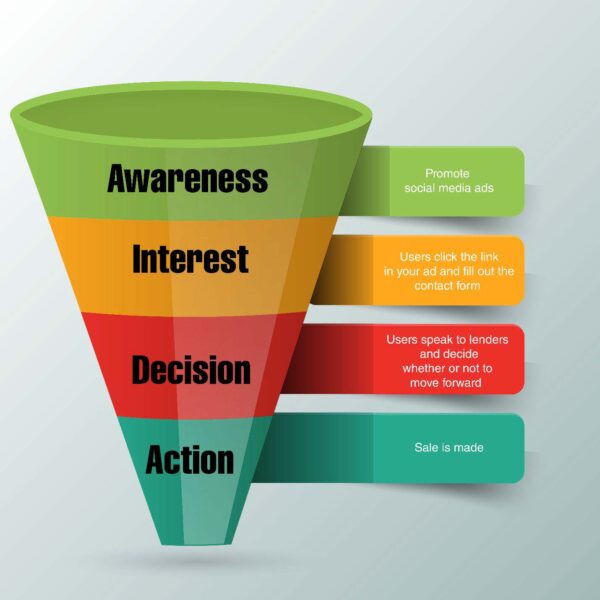In the current digital age, it’s a waste of an opportunity when a business doesn’t have a social media presence. Maybe they have a Facebook profile but the last time they posted was in 2018. Unfortunately, this can be seen for many small, local banks. Most of the time it’s because they don’t see the value in posting and they don’t believe it could generate revenue. However, that is very wrong. Using a sales funnel for your social media strategy can convert Facebook users into paying customers. The funnel can be used for organic content and paid content. In this example, we’ll show you how to use paid content and the sales funnel to generate revenue.

Step 1: Awareness
The first step is where consumers learn everything you have to offer. Let’s say your bank wants to push its new lending program for business owners. LinkedIn would be a great platform for targeting your audience. Since these consumers may be meeting your brand for the first time, you may want to start with ads that promote brand awareness. Later you can transition to ads about your commercial lending program. Conduct AB testing with these types of posts to see which gains more views and engagement. If you’ve never heard of AB testing, here’s what it is and how it can help you succeed in paid social media marketing.
Step 2: Interest
During your ad campaign, users may start to have an interest in your promotion and click the ad link. Once on your landing page, they may have the option to fill out a contact form. Please note that if users are clicking to the website and then are automatically bouncing off or no one is filling out the contact form, you need to take a close look at the landing page’s content. Or if no one is clicking the ad link, look at who you’re targeting and the ad itself. Sometimes, the target audience and message may need to be tweaked.
Pro Tip: If you would like your funnel to be more streamlined – this step can be divided into two. One for clicking the ad link and the other for filling out the contact form.
Step 3: Decision
The decision is whether they wish to continue with the lending process once they’re on the phone with the commercial lender. Don’t be afraid to reach out to the commercial lenders on their experience with the consumers who said no. They can give you valuable insight into why the person decided not to move forward. This information can later be used to edit your ad and messaging.
Step 4: Action
This step is the bank CEO’s favorite – you make the sale! The final step is when the consumer fills out the commercial loan application and goes through the bank lending journey.
This is not a definite funnel and there can be many more steps and different paths. Regardless if you’re trying to build revenue or brand awareness, sale funnels can also be used for your organic posts. Prepare yourself for any complications along the way, where users are not going down the funnel. This will require you to figure out why they aren’t going to the next desired step and to tweak your content accordingly. Bank marketing doesn’t have to be stuck in the old ages of print ads or radio spots, dip your toes in social media marketing and see the benefits it can reap for you!





Hi, this is a comment.
To get started with moderating, editing, and deleting comments, please visit the Comments screen in the dashboard.
Commenter avatars come from Gravatar.